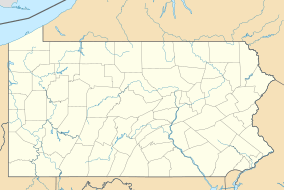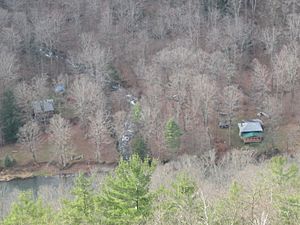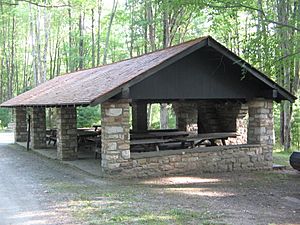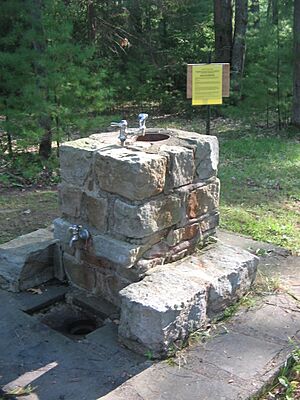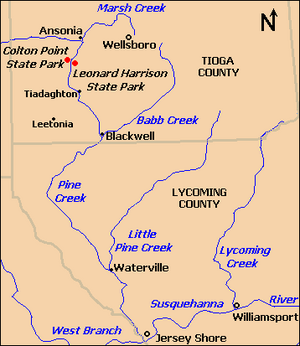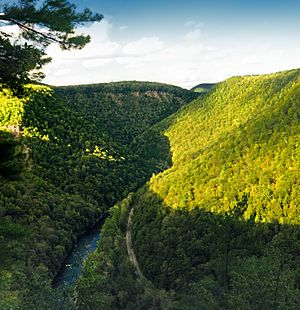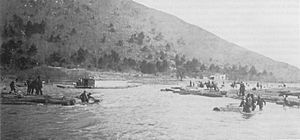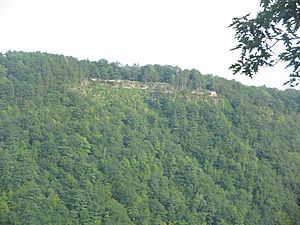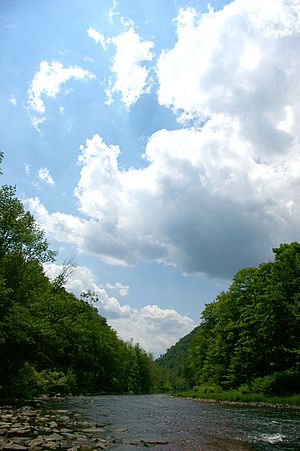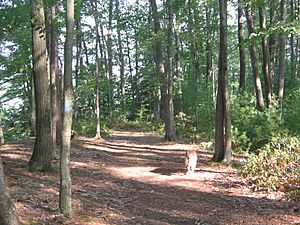Colton Point State Park facts for kids
Quick facts for kids Colton Point State Park |
|
|---|---|
|
IUCN Category III (Natural Monument)
|
|

CCC-built overlook looking south into the Pine Creek Gorge in Colton Point State Park
|
|
| Location | Shippen, Tioga, Pennsylvania, United States |
| Area | 368 acres (149 ha) |
| Elevation | 1,637 ft (499 m) |
| Established | 1936 |
| Named for | Henry Colton |
| Visitors | 87,423 |
| Governing body | Pennsylvania Department of Conservation and Natural Resources |
| Website | Colton Point State Park |
Colton Point State Park is a beautiful 368-acre (149 ha) state park in Tioga County, Pennsylvania. It sits on the west side of the Pine Creek Gorge. This gorge is often called the Grand Canyon of Pennsylvania. It is about 800 feet (240 m) deep and nearly 4,000 feet (1,200 m) wide here.
The park stretches from the creek at the bottom of the gorge up to its rim. It also covers part of the flat land to the west. Colton Point State Park is famous for its amazing views of the Pine Creek Gorge. It's a great place for picnics, hiking, fishing, and camping. You can also go whitewater boating.
Colton Point is surrounded by Tioga State Forest. Its sister park, Leonard Harrison State Park, is on the east rim of the gorge. The park is located on a state forest road about 5 miles (8 km) south of U.S. Route 6.
Pine Creek flows through the park. It has carved the gorge through five main rock layers over millions of years. Long ago, Native Americans used the Pine Creek Path along the creek. Later, lumberjacks used it. Then, a railroad followed this path from 1883 to 1988.
Since 1996, the 62-mile (100 km) Pine Creek Rail Trail has followed the creek. The Pine Creek Gorge was named a National Natural Landmark in 1968. It is also a Pennsylvania State Natural Area and an Important Bird Area. Pine Creek itself is a Pennsylvania Scenic and Wild River. The gorge is home to many plants and animals. Some animals have even been brought back to the area.
The park is named after Henry Colton. He was a lumberman from Williamsport. He started cutting timber here in 1879. The Pine Creek Gorge was once completely cut down (clearcut). But now it's covered by new forests. This is thanks to groups like the Civilian Conservation Corps (CCC) in the 1930s.
The CCC built many of the park's buildings before it opened in 1936. Most of these CCC-built structures are still used today. They helped the park become listed as a historic district on the National Register of Historic Places. Since a big advertising campaign in 1936, the park and gorge have been popular. Hundreds of thousands of people visit each year. Colton Point State Park is on the "25 Must-See Pennsylvania State Parks" list. This list praises its "spectacular vistas and a fabulous view of Pine Creek Gorge".
Contents
Park History: From Ancient Times to Today
Native American Life in the Gorge
People have lived in Pennsylvania for at least 12,000 years. The first people were Paleo-Indian hunters who moved around a lot. Later, people used more advanced stone tools. Around 1000 BC, people started living in villages and growing plants.
Colton Point State Park is in the West Branch Susquehanna River area. The first people recorded here were the Susquehannocks. They lived in villages with large long houses. They sometimes lived in the mountains around Pine Creek Gorge. Their numbers went down due to sickness and wars. By 1675, they had mostly left or joined other tribes.
After this, the Iroquois controlled the land. The Iroquois lived mostly in what is now New York. They had a strong group of tribes. They and other tribes used the Pine Creek Path through the gorge. They traveled between New York and the Great Shamokin Path to the south. The Seneca tribe of the Iroquois thought Pine Creek Gorge was special. They never built a permanent home there. They used the path for hunting camps.
Later, the French and Indian War (1754–63) caused many Native Americans to move west. In 1768, the British bought land from the Iroquois. This included the Pine Creek Gorge east of the creek. After the American Revolutionary War, most Native Americans left Pennsylvania. Some small groups stayed in Pine Creek Gorge until 1812.
The Lumber Era: Forests to Farmland
Before 1682, most of Pennsylvania was covered in thick forests. These forests had huge eastern white pine and eastern hemlock trees. Early settlers used this wood for building and cleared land for farms. By the time of the American Revolution, logging was a major industry. Trees were used for fuel, leather tanning, and building.
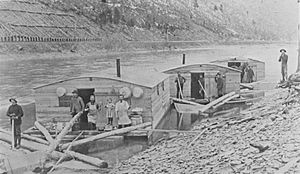
By the early 1800s, lumber demand reached the Pine Creek Gorge. The mountainsides had giant white pines, some 3 to 6 feet (1 to 2 m) wide and 150 feet (50 m) tall. Shipbuilders thought pine from Pine Creek was the best for ship masts. So, it was the first wood cut on a large scale. The land that is now Colton Point State Park was sold in 1792.
Pine Creek was made a public waterway in 1798. Logs were floated down the creek to the Susquehanna River. Then they went to shipbuilders in Baltimore. Lumberjacks would walk home along the old Pine Creek Path.
As time went on, fewer pines were left. More hemlocks and hardwoods were cut. By 1840, there were 145 sawmills in the Pine Creek area. Instead of picking certain trees, loggers started cutting down all trees in an area (clearcutting). In 1871, a law allowed building splash dams. This helped float loose logs down the creek.
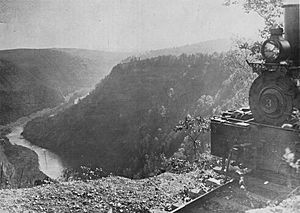
In 1879, Henry Colton oversaw the cutting of white pine here. This land later became the park. Colton Point overlook is named after him. Deadman Hollow Road in the park is named for a trapper found in his own bear trap.
In 1883, a railroad opened along Pine Creek. It linked New York to coal fields and Williamsport. Logging railroads also moved lumber to local sawmills. By 1900, a logging railroad reached Colton Point. This allowed logging of trees that were hard to reach before.
By the early 1900s, the old forests were gone. The gorge was bare. Dry tree tops caused many fires. Much of the land burned and was left empty. The soil lost its nutrients. Floods swept through the area. Much of the wildlife disappeared.
Protecting the Gorge: From Desert to Park
George Washington Sears, a writer and early conservationist, criticized the logging industry. He wrote about the damage to Pine Creek in 1884. He called the clearcut areas "desolation." Sears lived in Wellsboro and was the first to describe the Pine Creek Gorge. He wrote about the amazing view from "The Point," which is now Leonard Harrison State Park.
The land that became Colton Point State Park was sold to Pennsylvania. It was bought for a low price because lumber companies no longer needed it. These lands became the Tioga State Forest, created in 1925. This forest surrounds Colton Point State Park. In 1922, Leonard Harrison, a lumberman, gave his picnic grounds on the east rim to Pennsylvania. This became Leonard Harrison State Forest Park.
The Civilian Conservation Corps and Modern Era
The Civilian Conservation Corps (CCC) started working on Colton Point in June 1935. The park opened in 1936. The CCC was a program created by President Franklin D. Roosevelt during the Great Depression. It gave jobs to young men. Much of the CCC's work at Colton Point is still here today.
In 1936, local business owners started calling the Pine Creek Gorge "The Grand Canyon of Pennsylvania." This helped bring many tourists. By autumn 1936, over 300,000 tourists visited. In 1937, more people visited Pine Creek Gorge than Yellowstone National Park. The CCC widened roads and gave tours.
Colton Point first opened with few facilities. But the tourism success led to more building by the CCC in 1938. They built picnic shelters, restrooms, and a concession stand. They also made stone cook stoves, tables, and trails. They did "an amazing amount of work in one year." The CCC also built the park road and planted new trees.
On February 12, 1987, the entire 368-acre (149 ha) park was listed on the National Register of Historic Places (NRHP). This included eight buildings and nine structures. The CCC built five picnic shelters, six rustic restrooms, and an underground water tank. They also built three overlooks and a maintenance building. These buildings show a "rustic style" using local, natural materials.
The park was officially named "Colton Point State Park" in 1954. In 1970, a camping area was added. A new water system was built in 1973. A park office was built in 1983, but today the main office is at Leonard Harrison State Park. Pine Creek was named a state scenic river in 1992. This helps protect the gorge. In 1997, the park became an Important Bird Area. In 2000, it joined a group of eight state parks managed together. As of 2004, the park uses solar cells for some electricity.
The railroad through the gorge changed too. Passenger service ended after World War II. In 1988, the railroad section through the gorge was closed. This old railroad path became the Pine Creek Rail Trail. The first part of the trail opened in 1996. Today, the Pine Creek Rail Trail is 62 miles (100 km) long.
Colton Point State Park has continued to be popular. The New York Times has praised its "breath-taking views" and trails. The Pine Creek Gorge was named a National Natural Landmark in 1968. In the new millennium, Colton Point and Leonard Harrison state parks are often seen as one. They are on the "25 Must-See Pennsylvania State Parks" list.
The Grand Canyon of Pennsylvania
Colton Point State Park is on the west side of the Pine Creek Gorge. This gorge is also called the Grand Canyon of Pennsylvania. Leonard Harrison State Park is on the east side. Together, these two parks form a large protected area. Pine Creek has carved this gorge for nearly 47 miles (76 km) through the Allegheny Plateau. The canyon starts in southwestern Tioga County and goes south into Lycoming County. In Colton Point State Park, the gorge is about 800 feet (240 m) deep and nearly 4,000 feet (1,200 m) wide.
The Pine Creek Gorge National Natural Landmark includes both parks and parts of the Tioga State Forest. This landmark program recognizes special natural places. It notes that the gorge has "superlative scenery, geological and ecological value." It is also "one of the finest examples of a deep gorge in the eastern United States."
The gorge is also protected by Pennsylvania as the 12,163-acre (4,922 ha) Pine Creek Gorge Natural Area. This is the second largest State Natural Area in Pennsylvania. Within this area, logging, mining, and drilling are not allowed. Only foot trails are permitted. This helps protect the natural beauty of the canyon.
Pine Creek and the gorge walls are also protected as a Pennsylvania Scenic River. This means the creek is kept in its natural state. It is protected from dams and water removal. This helps keep the creek healthy for fish and other wildlife.
Rocks, Weather, and Wildlife
How the Gorge Was Formed
The rocks in Colton Point State Park are over 300 million years old. But the gorge itself is much younger. It formed about 20,000 years ago during the last ice age. Before then, Pine Creek flowed northeast. But a large glacier blocked it. This created a lake near what is now Ansonia. The melting ice overflowed the dam, making Pine Creek flow south. The creek quickly carved the deep gorge we see today.
The park is at 1,637 feet (499 m) elevation on the Allegheny Plateau. This plateau formed about 300 million years ago when continents collided. Even though the gorge looks mountainous, it's actually a dissected plateau. Over millions of years, erosion wore away softer rocks. This left the harder rocks on top of ridges, making them look like mountains.
The land here was once a shallow sea. Mountains to the east eroded, filling the sea with sediment. This sediment formed the rocks found in the gorge today. These include sandstone, shale, conglomerates, limestone, and coal.
There are five main rock layers in the park. The youngest is the Pottsville Formation. It forms the highest points and is a gray rock that can contain coal. Below this is the Mauch Chunk Formation, a reddish rock. These two layers are about 300 feet (91 m) thick.
Next is the Huntley Mountain Formation, a reddish and olive-gray rock. Below that is the Catskill Formation, a red shale and siltstone. This layer is soft and easily eroded, which helped form the gorge. The oldest layer is the Lock Haven Formation. It is gray to green-brown and forms the base of the gorge. It contains sea fossils and is over 400 million years old.
Park Climate
The Allegheny Plateau has a continental climate. Winters can be very cold. Summers have a daily temperature change of about 26°F (14°C). The area gets about 36 to 42 inches (914 to 1,070 mm) of rain each year. The highest temperature recorded was 104 °F (40 °C) in 1936. The lowest was −30 °F (−34 °C) in 1934.
| Climate data for Colton Point State Park | |||||||||||||
|---|---|---|---|---|---|---|---|---|---|---|---|---|---|
| Month | Jan | Feb | Mar | Apr | May | Jun | Jul | Aug | Sep | Oct | Nov | Dec | Year |
| Mean daily maximum °F (°C) | 30 (−1) |
33 (1) |
41 (5) |
54 (12) |
65 (18) |
73 (23) |
77 (25) |
76 (24) |
68 (20) |
58 (14) |
45 (7) |
34 (1) |
55 (12) |
| Mean daily minimum °F (°C) | 13 (−11) |
15 (−9) |
23 (−5) |
33 (1) |
43 (6) |
52 (11) |
56 (13) |
54 (12) |
48 (9) |
38 (3) |
30 (−1) |
19 (−7) |
35 (2) |
| Average precipitation inches (mm) | 1.88 (48) |
1.72 (44) |
2.40 (61) |
2.52 (64) |
3.05 (77) |
4.56 (116) |
3.66 (93) |
2.92 (74) |
3.23 (82) |
2.60 (66) |
2.77 (70) |
2.12 (54) |
33.43 (849) |
| Source: The Weather Channel | |||||||||||||
Plants and Animals of the Gorge
Before logging, the Pine Creek Gorge was mostly hemlock and white pine trees. It was home to many animals. Some, like American bison and wolves, are no longer here. Others, like bobcats and foxes, still live here. In 1794, explorers found so many rattlesnakes that they slept in their canoe!
The old forests kept the land and streams cool. Pine Creek had many fish, including trout. But dams downstream stopped fish like shad and salmon from migrating. Clearcutting destroyed animal homes. Also, a lot of hunting happened.
Today, Colton Point and Leonard Harrison State Parks are part of a State Natural Area. This protects them. Logging, mining, and drilling are not allowed. Only foot trails are permitted. This helps keep the area as natural as possible.
The gorge has over 225 kinds of wildflowers, plants, and trees. Some parts have very old forests on steep walls. Most of the gorge has thriving new forests, over 100 years old. Many areas burned after clearcutting. South-facing slopes have mountain laurel under oak and hickory trees. North-facing slopes have ferns under hemlocks and hardwoods.
The Grand Canyon of Pennsylvania is famous for its fall colors. Colton Point State Park is a great place to see them. The best time is the first three weeks of October. Red leaves come from red maple and black cherry trees. Orange and yellow leaves are from black walnut and sugar maple.
Over 40 kinds of mammals live in the Pine Creek Gorge. The park's forests are home to white-tailed deer, black bear, wild turkey, and squirrels. Less common animals include bobcats, coyotes, and timber rattlesnakes. Pine Creek has over 26 kinds of fish, including trout and smallmouth bass.
Some animals have been brought back to the gorge. White-tailed deer were brought from Michigan. River otters were successfully reintroduced in 1983. They now have babies in the gorge. Fishers, a type of weasel, were also brought back. Elk sometimes wander near the canyon's west rim. Coyotes have returned on their own.
Some invasive insects are a problem. Gypsy moth larvae eat tree leaves. Hemlock woolly adelgids harm hemlock trees. Invasive plants like purple loosestrife are also found.
Important Bird Area
Colton Point State Park is part of Important Bird Area #28. This area covers 31,790 acres (12,860 ha) of public and private land. It is a very important place for birds. Over 128 kinds of birds have been seen here. This is because of the large forest area and different types of habitats.
Bald eagles live here all year and have nests. Other birds include belted kingfishers, scarlet tanagers, and common mergansers. Many ospreys use the gorge during spring and fall. Wild turkeys and Pennsylvania's state bird, the ruffed grouse, live in the woodlands.
Many different warblers are found in Colton Point State Park. The Pennsylvania Audubon Society says the gorge is "especially rich in warbler species." These include Pine, Black-throated blue, and Blackburnian warblers. These small birds are often heard but not seen.
Fun Things to Do
Hiking Trails
Colton Point State Park has challenging hikes. There are 4.0 miles (6.4 km) of trails. The terrain is very rugged. Trails can be slippery and pass near steep cliffs. In 2003, over 18,000 people used the park's trails.
- Rim Trail (yellow markers) is a 1-mile (1.6 km) loop trail. It is mostly flat. It follows the edge of Colton Point and connects all the canyon viewpoints.
- Turkey Path (blue markers) is a difficult trail, 3 miles (5 km) long (down and back). It goes down the side of the canyon, dropping over 800 feet (240 m) to Pine Creek. There is a 70-foot-tall (21 m) waterfall about 0.5 miles (0.80 km) down the trail. You cannot cross Pine Creek here. The Turkey Path continues in Leonard Harrison State Park.
- Pine Creek Rail Trail is a 62-mile-long (100 km) rail trail. It goes from Wellsboro Junction south through the Pine Creek Gorge. About 1 mile (1.6 km) of this trail is in Colton Point and Leonard Harrison State Parks. USA Today called it one of the "10 great places to take a bike tour" in the world.
- West Rim Trail is a 30.5-mile-long (49.1 km) hiking trail. It runs along the west rim of the Pine Creek Gorge. It passes through the northern part of the park. Outside Magazine named it the "Best Hike in Pennsylvania" in 1996.
Camping and Picnics
Camping is popular at Colton Point State Park. In 2003, nearly 2,000 people camped here. The campsites are rustic, with no modern toilets or showers. They have outhouses, fire rings, and picnic tables. There is also a dump station for RVs. An Organized Group Tenting area can hold up to 90 campers. Over 1,400 campers used this area in 2003. The park also has about 100 picnic tables and five CCC-built picnic shelters. These shelters can be reserved. Over 15,000 people had picnics here in 2003.
Hunting, Fishing, and Boating
Hunting is allowed in 100 acres (40 ha) of Colton Point State Park. It is managed by the Pennsylvania Game Commission. Common animals to hunt are ruffed grouse, squirrels, wild turkey, white-tailed deer, and black bears. Hunting groundhogs is not allowed. More hunting land is available in the nearby Tioga State Forest.
Fishing is also allowed. You can reach Pine Creek by going down the Turkey Path. Fish found in Pine Creek include trout, smallmouth bass, and some panfish. There are also small trout streams in the park. Famous anglers, like President Theodore Roosevelt, have fished this part of Pine Creek.
Edward Gertler, who writes about canoeing, calls Pine Creek "possibly Pennsylvania's most famous canoe stream." Many people boat on it after seeing the gorge from the overlooks. The park has 1 mile (1.6 km) of Pine Creek. This section is considered Class 1 to Class 2 whitewater. Boaters usually start or end their trip outside the park.
Nearby State Parks
Colton Point State Park is in Shippen Township. It is 5 miles (8 km) south of U.S. Route 6. The following state parks are within 30 miles (50 km) of Colton Point State Park:
|
|


